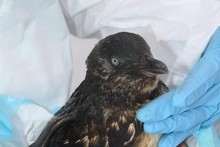by Genevieve Helliwell |
Thursday, October 27, 2011

Penguin enclosures.
John Borren
The race is on to complete specialised penguin enclosures that will give hundreds of birds a new lease on life.
By lunchtime today (Thursday) builders will have completed six specialised penguin enclosures, each measuring 6m x 9m.
About a dozen builders, predominantly from DWYERtech Services, aim to
finish four more enclosures by the end of next week for long-term care
of the 314 penguins at the Wildlife Rescue Centre at Te Maunga.
Each enclosure can house up to 30 penguins and includes a large pool
where penguins can swim and play, as well as large communal areas where
they can preen and feed.
Wildlife Recovery Centre facility manager Bill Dwyer and his team began
building the first penguin enclosure on Sunday and had begun five more
since Tuesday.
He is in charge of deciding where buildings and tents will be erected
at the Wildlife Recovery Centre - a role he's had since Rena struck the
Astroblabe Reef, leaking its fuel into the ocean three weeks ago.
The enclosures are made with three tiers of materials - polyethylene
plastic sheets layered underneath plastic pellets with a thin layer of
tubing so it doesn't hurt the penguins' feet, Mr Dwyer said.
Mr Dwyer said he wasn't sure how long the birds would remain inside the
enclosures but they could be a long-term solution if necessary.
"As long as there's an issue with oil, these penguins can stay as long as they like," he said.
Until now the penguins have been living in small basket-like enclosures and moved to a pool to swim.
Working on such a task has been a challenge, as Mr Dwyer has never made
a penguin enclosure before but he said it was a rewarding experience.
He is a member of the New Zealand Wildlife Health Centre at Massey
University in Palmerston North and worked in the wildlife recovery after
the Jody F spill in 2002. However, on this occasion, there were a lot
more birds to deal with than back then.
"We didn't know how to approach this so [we] drew up a plan and sort of went from there," he said.
The 314 penguins in the Wildlife Recovery Centre get fed twice a day and eat five to seven fish at each feeding.
They also have one swim a day. This lets them condition and preen their feathers, which is crucial to their re-waterproofing.
Oiled Wildlife Response manager Kerri Morgan said it was important to
monitor the penguin's health and condition, especially at feeding times.
"Correct feeding is a critical part of the rehabilitation process and
our staff take great care when feeding the penguins," Ms Morgan said.
"We use either sprats or anchovies and need to ensure that none of the
natural oils from the fish get on the birds' feathers as this can damage
their natural waterproofing."
Ms Morgan said it was too early to tell when the penguins could be
released but the focus was on ensuring they were all healthy and
well-nourished before being released back into the wild.
She said all the penguins were "doing really well and have a great fighting spirit".
The centre now has 379 live birds in its care. The number of dead birds
stands at 1370. Investigations are being carried out on the birds to
determine if oiling was the cause of death.
source










 Little blue penguins all cleaned up at the Oil Wildlife Centre.
Little blue penguins all cleaned up at the Oil Wildlife Centre. 







 Penguins come from North Dakota
Penguins come from North Dakota





















